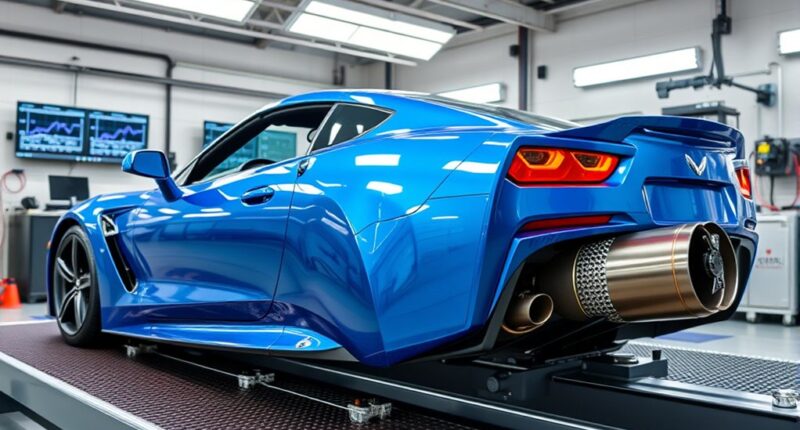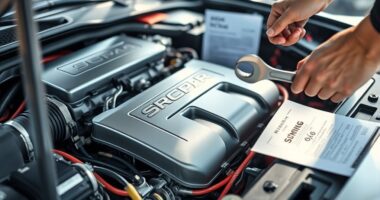To pass emissions testing with a tuned car, start by understanding local regulations and keep detailed records of modifications. Regular maintenance, like oil changes and sensor checks, is essential. Before testing, perform a thorough pre-inspection, warm up your engine properly, and ensure sensors are functioning correctly. Use high-quality fuel and additives to keep emissions low. If you want to fine-tune your setup for success, there’s more to learn that can boost your chances.
Key Takeaways
- Ensure your vehicle is properly warmed up to the recommended temperature (190°F-220°F) before testing.
- Regularly inspect and replace sensors like oxygen and MAF to guarantee accurate emissions readings.
- Maintain a clean, leak-free exhaust system with high-flow catalytic converters for improved emissions performance.
- Keep detailed records of all modifications, repairs, and maintenance to verify compliance during testing.
- Use high-quality fuels and additives to promote cleaner combustion and reduce emissions during the test.
Understand Your Local Emissions Regulations
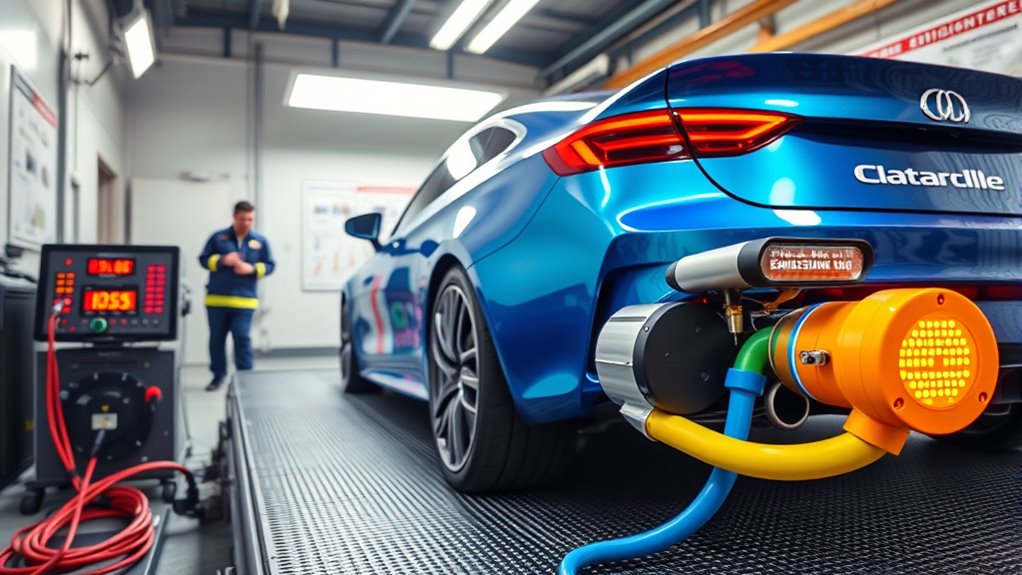
To guarantee your tuned car passes emissions testing, you first need to understand your local emissions regulations. Regulations vary widely by city, state, or country, so it’s essential to research specific requirements where you’ll be testing.
Check the official government or environmental agency websites for detailed standards on emissions limits and testing procedures. Some areas have strict rules for modified or tuned vehicles, especially if aftermarket parts affect emissions output. Being aware of emissions standards helps you know what limits your vehicle must meet.
Consult official government websites for emissions standards and testing procedures.
Knowing these details helps you identify potential issues before testing day. You might also find information on required paperwork, testing intervals, and exemptions.
Staying informed ensures you’re prepared, reduces surprises, and increases your chances of passing on the first try. Failing to understand regulations can lead to costly retests or modifications. Trust issues with your vehicle’s emissions system can sometimes be a sign of deeper mechanical problems that need addressing before testing.
Keep Your Vehicle Well-Maintained
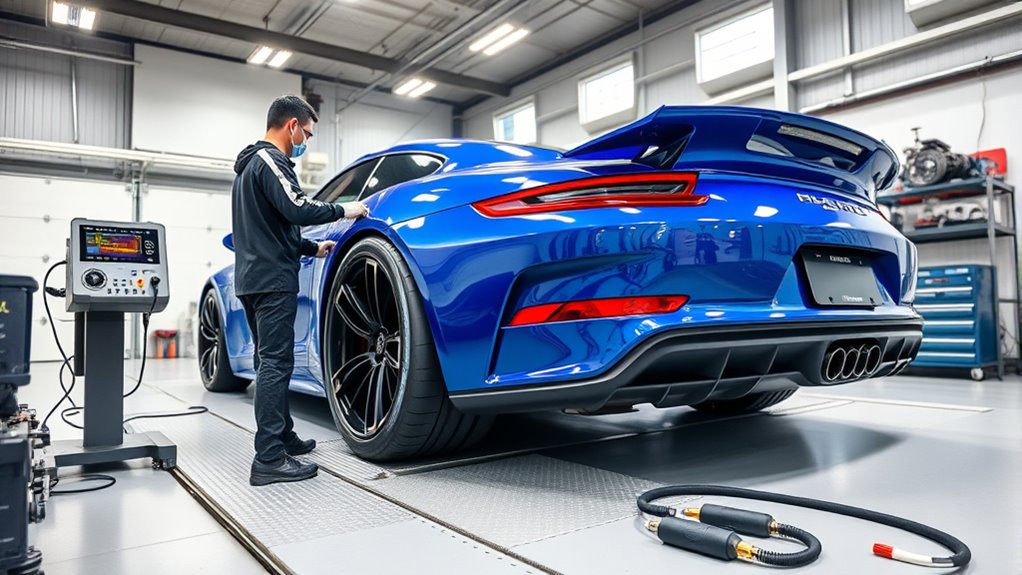
Maintaining your vehicle regularly is essential to passing emissions tests, especially for tuned cars that often have modified components. Consistent oil changes keep your engine running smoothly and reduce harmful emissions. Check and replace air filters to ensure proper airflow, which improves combustion efficiency. Regularly inspect and maintain your spark plugs and ignition system, as faulty parts can increase emissions. Keep your fuel system clean by using quality fuel and additives if needed. Ensure your exhaust system is free of leaks and damage, as these can cause emissions to spike. Proper tire inflation and wheel alignment also help your vehicle operate efficiently. Staying on top of routine maintenance not only improves your car’s performance but also guarantees it stays within emission standards. Preventive measures can help identify potential issues before they cause your vehicle to fail an emissions test. Additionally, understanding industry trends can guide you in adopting the latest practices for emission control. Using a diagnostic scan tool can assist in pinpointing underlying problems that may affect emissions and overall vehicle health. Regularly utilizing essential oils for vehicle maintenance, such as eucalyptus or tea tree oil, can support engine cleanliness and reduce emissions by preventing buildup. Incorporating crochet techniques for vehicle customization can also promote careful handling during repairs and modifications.
Use a Pre-Testing Inspection
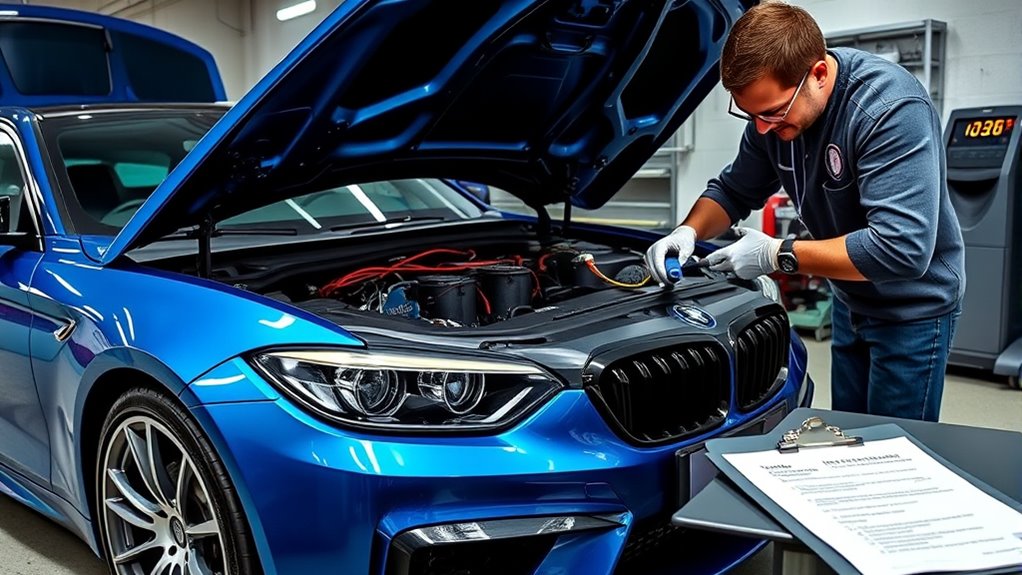
Before heading to the testing station, it’s wise to perform a thorough pre-testing inspection on your vehicle. Start by checking your tire pressure, fluid levels, and brake condition to ensure everything is in good shape.
Perform a thorough pre-testing inspection: check tires, fluids, brakes, and look for warning lights to ensure your vehicle is ready.
Inspect your exhaust system for leaks, rust, or damage, as these can cause emissions issues. Verify that your catalytic converter and oxygen sensors are functioning properly, since faulty components can lead to test failures.
Look for any warning lights on your dashboard, and address issues before the test day. Also, make certain your engine is warmed up and running smoothly.
This pre-inspection helps catch potential problems early, giving you time to fix them and improving your chances of passing the emissions test without surprises.
Optimize Your Engine Tuning Settings

To improve your emissions and performance, you should fine-tune your fuel mixture to guarantee it’s neither too rich nor too lean. Additionally, understanding performance tuning laws can help you make modifications that are both effective and compliant with regulations. Next, adjust your ignition timing to maximize efficiency and reduce pollutants. Properly calibrating your ECU can also ensure your engine runs optimally within emission standards. Maintaining proper sensor calibration is essential for accurate readings during testing. Finally, optimize your exhaust flow to minimize backpressure and help your vehicle meet emissions standards. Proper maintenance of your arcade game hardware is also essential to ensure consistent performance and accurate readings during testing.
Fine-tune Fuel Mixture
Fine-tuning your fuel mixture is vital to achieving ideal engine performance and lower emissions. Start by adjusting the air-to-fuel ratio to guarantee your engine runs efficiently. A slightly richer mixture can improve power, but too much fuel increases emissions and wastes fuel. Conversely, a leaner mixture reduces emissions but can cause knocking or hesitation if too extreme. Use a wideband oxygen sensor to monitor your air-fuel ratio in real time. Make small adjustments incrementally, then test your vehicle to observe changes in performance and emissions. Staying informed about emission standards can help you maintain optimal tuning and ensure your vehicle remains environmentally compliant. Incorporating mindfulness techniques during testing can help you stay focused and attentive to subtle engine responses for more precise tuning.
Adjust Ignition Timing
Adjusting your ignition timing is essential for maximizing engine efficiency and minimizing emissions. Proper timing ensures your spark ignites the fuel-air mixture at the *best* moment, leading to smoother combustion. Using a timing light and following your vehicle’s specifications is crucial for precise adjustment. Start the engine and connect the light to the number one cylinder. Rev the engine to the recommended RPM and align the timing mark with the specified degree. Make small adjustments until the timing is precisely set. Accurate ignition timing improves power, reduces pollutants, and helps pass emissions tests more easily. Proper tuning also ensures your engine runs smoothly and efficiently, preventing potential damage caused by incorrect timing. Additionally, considering engine tuning options like ECU remapping can further optimize emissions and performance. Staying informed about emissions testing standards can help you better prepare your vehicle for inspections and avoid costly repairs.
Optimize Exhaust Flow
Optimizing exhaust flow is crucial for maximizing your engine’s performance and reducing emissions. When you improve exhaust flow, you help your engine breathe better, which boosts power and efficiency.
To do this effectively:
- Upgrade your exhaust system with larger pipes to decrease backpressure.
- Install high-flow catalytic converters to ensure smooth emission passage.
- Use mandrel bends in your piping to prevent turbulence and maintain ideal airflow.
- Pay attention to air-fuel mixture adjustments, as proper tuning complements exhaust modifications and enhances overall emissions performance. Maintaining optimal engine tuning settings ensures all components work harmoniously for better results. Additionally, understanding how emissions standards impact your vehicle can help guide your modifications for compliance and optimal performance.
Visualize the exhaust gases moving freely through wider pipes, smoothly passing through high-flow catalysts, and exiting without resistance. These adjustments allow your engine to expel gases more efficiently, lowering emissions and increasing power.
Properly tuning your exhaust system not only benefits performance but also helps your vehicle meet emissions standards, making your tuned car both powerful and eco-friendly.
Perform a Proper Warm-Up Before Testing
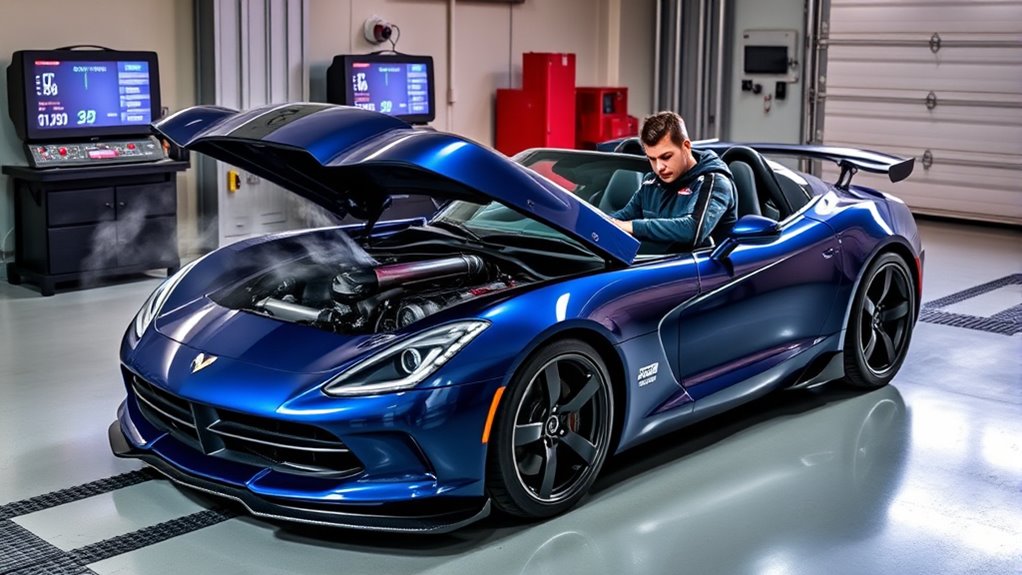
Before testing, make sure your engine reaches its ideal temperature for accurate results. Let the engine idle steadily for a few minutes to ensure all components are warmed up properly. This proper warm-up process can help reduce emissions and improve test accuracy. Additionally, maintaining consistent testing procedures during your testing can ensure reliable and repeatable results. Ensuring your vehicle’s emission control system is functioning properly before testing can further enhance accuracy and compliance. Being aware of automation in business can also contribute to understanding how technological advancements impact vehicle testing and regulation enforcement.
Optimal Engine Temperature
To guarantee accurate emissions testing, you need to warm up your tuned car to its ideal engine temperature. This ensures the engine runs efficiently and emissions readings are reliable. To achieve this, focus on reaching the right temperature range, usually between 190°F and 220°F. Visualize your engine:
- The temperature gauge needle slowly rises, signaling heat spreading through the cylinders.
- The exhaust fumes shift from cold, dense vapor to a steady, warm flow.
- The engine runs smoothly, with stable idling and no hesitations.
- Incorporating mindfulness practices during warm-up can help maintain optimal engine performance by reducing unnecessary engine strain. Paying attention to engine health during this process ensures a more consistent and thorough warm-up.
Steady Idle Time
Once your engine reaches its proper operating temperature, maintaining a steady idle is vital for a reliable warm-up before testing. This helps ensure consistent emissions readings and prevents false results. Keep the engine running smoothly without revving or sudden acceleration. Be patient and let it sit at a stable RPM for a few minutes. During this time, your engine components stabilize, reducing fluctuations during testing. To help you visualize the process, here’s a quick guide:
| Warm-Up Duration | RPM Range | Key Tip |
|---|---|---|
| 3-5 minutes | 800-1000 | Avoid revving excessively |
| 5-10 minutes | 700-900 | Maintain a steady pace |
| 10+ minutes | 700-800 | Ensure engine stability |
| Final Check | N/A | Confirm steady idle |
Check and Replace Faulty Sensors
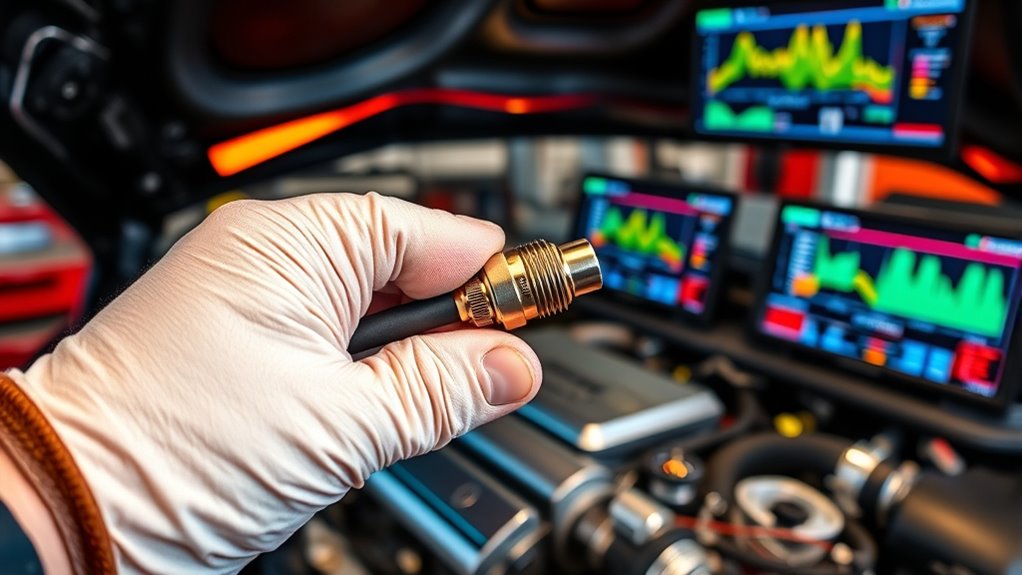
Faulty sensors can substantially impact your emissions test results, so it’s vital to verify their functionality before proceeding. Start by inspecting key sensors like the oxygen sensor, MAF sensor, and coolant temperature sensor.
- Visualize disconnecting each sensor, checking for corrosion, cracks, or dirt that might block signals.
- Use a scan tool to read live data, confirming if sensor readings stay within normal ranges.
- Replace any sensor showing inconsistent or out-of-range values to ensure accurate emissions readings.
Use Quality Fuel and Additives
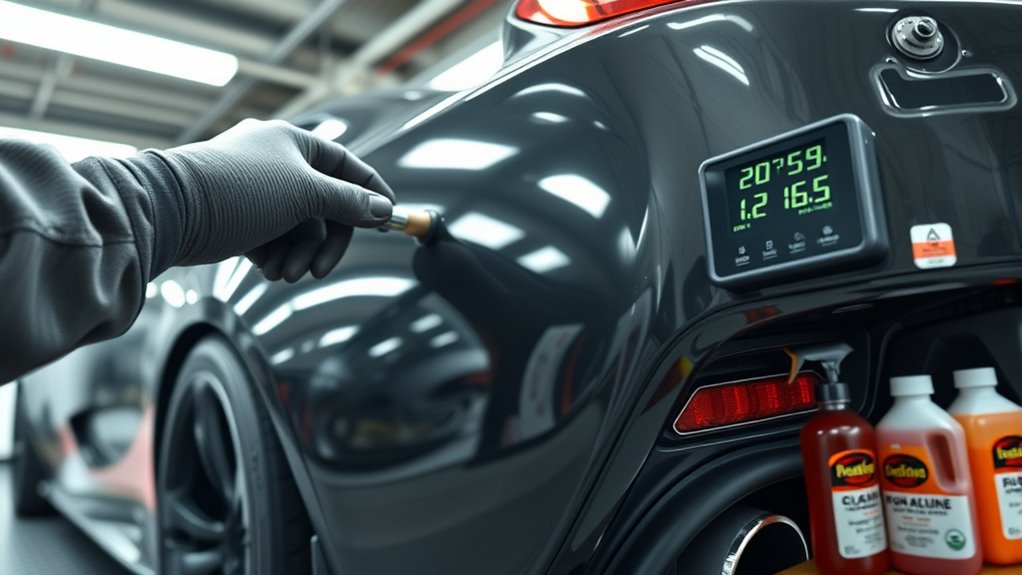
Using high-quality fuel and additives can markedly improve your vehicle’s emissions performance. Premium fuels burn cleaner, reducing harmful emissions and preventing buildup in your engine. Consider choosing fuels with detergents that help keep injectors and valves clean, ensuring efficient combustion.
Additives, like fuel system cleaners or octane boosters, can further optimize engine performance and reduce pollutants. Regular use of these products helps maintain proper fuel-air mixture, lowering emissions during testing.
Always follow the manufacturer’s recommendations for additives to avoid potential damage. By consistently using quality fuel and appropriate additives, you support a cleaner engine that runs more efficiently, ultimately making your emissions tests smoother and more successful.
This simple step can dramatically contribute to meeting emissions standards.
Consider a Professional Tune-Up Service
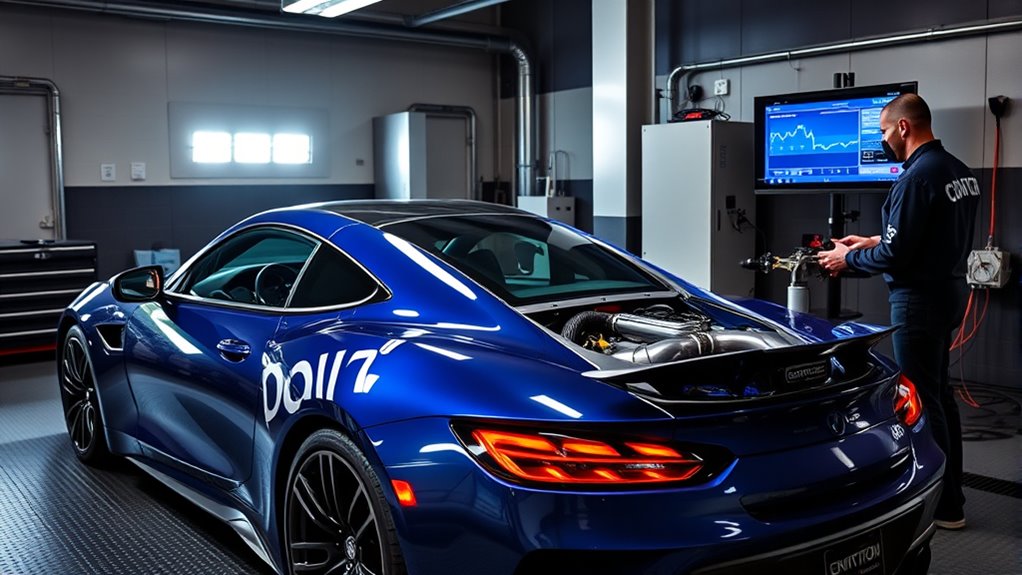
Scheduling a professional tune-up before emissions testing can substantially boost your vehicle’s performance and reduce pollutants. When you take your car to an experienced mechanic, they’ll typically:
- Inspect and replace worn spark plugs to improve combustion efficiency.
- Clean or replace the air filter, ensuring ideal airflow.
- Check and adjust the fuel injection system for precise fuel delivery.
This process ensures your engine runs smoothly, minimizes unburned fuel, and decreases harmful emissions. A professional tune-up also identifies underlying issues that could cause your vehicle to fail the test.
Keep Documentation of Modifications and Repairs
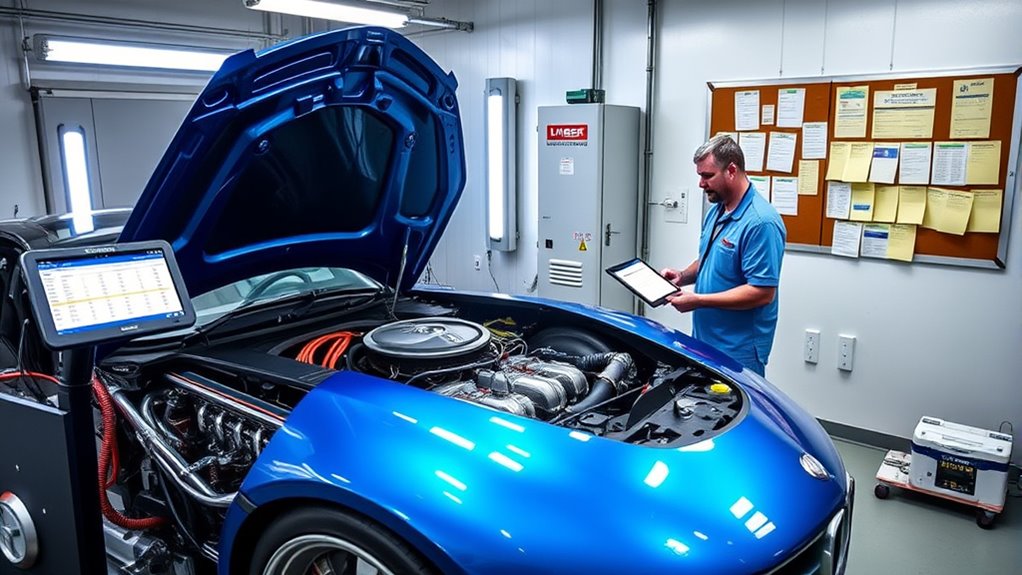
Keeping detailed records of any modifications and repairs made to your vehicle is essential when preparing for emissions testing. These documents demonstrate that your car has been properly maintained and that any upgrades comply with local regulations. Save receipts, invoices, and maintenance logs that detail parts replaced, tuning adjustments, and repair dates.
If you’ve installed aftermarket parts or made significant modifications, having proof can help the tester verify your vehicle’s compliance. Organized records also make it easier to identify potential issues if your vehicle fails the test, allowing for quicker resolution.
Keep digital copies and hard copies in a dedicated folder. Well-maintained documentation not only streamlines the testing process but also provides peace of mind that your vehicle meets emissions standards.
Frequently Asked Questions
How Often Should I Get My Tuned Car Tested for Emissions?
You should get your tuned car tested for emissions at least once a year or whenever local regulations require. Regular testing guarantees your modifications stay within legal limits and helps you avoid fines or issues during inspections.
If you’ve recently tuned your car or made significant changes, it’s wise to test sooner. Staying proactive keeps your vehicle environmentally friendly and compliant, giving you peace of mind on the road.
Can Aftermarket Modifications Affect My Emissions Test Results?
Imagine you’re in a bustling marketplace, and your modified car is like a vintage watch—unique but sometimes unpredictable. Aftermarket modifications can definitely impact your emissions test results.
They might improve performance but could also cause your vehicle to emit more pollutants or fail emissions standards. To avoid surprises, always check if your mods are legal and consider having your car tuned properly before testing.
It’s your best bet for passing smoothly.
Are There Specific Emissions Test Exemptions for Certain Vehicle Types?
You might wonder if certain vehicle types get exemptions during emissions tests. Generally, exemptions are rare and depend on local regulations.
Some classic or antique cars, for example, may qualify for limited exemptions, but most vehicles, including tuned cars, must meet standard standards.
To know for sure, check your area’s specific rules. Don’t assume your vehicle qualifies without verifying, as non-compliance could lead to penalties or failed inspections.
What Are the Penalties for Failing an Emissions Test?
When you fail an emissions test, you face several penalties. You might be required to repair your vehicle and retake the test within a specified timeframe.
If you don’t comply, you could incur fines, license suspensions, or vehicle registration holds. These penalties aim to guarantee your car meets environmental standards, so it’s best to address any issues promptly to avoid additional fines or restrictions.
How Long Does an Emissions Testing Process Typically Take?
Did you know that most emissions tests take about 20 to 30 minutes? When you go for the testing, you’ll typically arrive, check in, and wait briefly while the technician runs your vehicle through the process.
The actual test itself only lasts a few minutes. Factors like vehicle type and testing location can influence the duration, but generally, it’s a quick and straightforward process.
Conclusion
By following these tips, you’ll navigate emissions testing like a seasoned pilot steering through clear skies. Keep your tuned car shining bright like a star on a dark night, and let your modifications sing in harmony with regulations. Remember, a well-maintained vehicle isn’t just ready for the test—it’s ready to roar confidently down the road, turning heads and leaving pollution in the dust. So gear up, stay compliant, and let your car’s true performance shine through!
